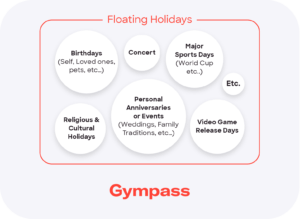Avoid Being a Total Scrooge With the Perfect Corporate Holiday PTO Plan
Last Updated Jan 28, 2025

There are holidays, and then there are Holidays — and not all of them warrant the same level of celebration. New Year’s Day, for example, tends to invoke more jubilation than, say, National Bubble Wrap Day. As such, there are certain holidays where it is generally expected and accepted that employees put in a full day’s work. And it’s not only the wired ones that get this kind of treatment; even A-listers like Halloween see the majority of the workforce at their desk with nose to the grindstone (costume optional).
The simple truth is that there are more holidays on the calendar than there are opportunities to give employees the day off. It falls on employers, therefore, to determine which holidays are appropriate for paid time off (PTO), and which can be properly recognized with a festive email greeting and a reminder to file those TPS reports by EOD.
In fact, having the right PTO holidays is considered a normal part of employee benefits and compensation and can be a deciding factor in attracting and retaining top talent. And considering that PTO ranks as one of the most important core benefits among employees (sitting in the #2 spot right behind health insurance), getting PTO right for your organization needs to be a top priority.
But before you create a PTO plan worthy of celebration, you should know what kinds of holidays you’re dealing with. So let’s take a look.
Types of Paid Holidays
Like we said earlier, not every holiday carries the same weight. Some holidays are so deeply ingrained in the work culture that failing to recognize them with PTO could have a disastrous effect on employee morale (just think of how anxious Kermit the Frog looked when Michael Caine said he was only going to give him half an hour off for Christmas).
What types of holidays are there? There are three different categories you’ll need to be aware of as you plan for your PTO corporate holiday schedule:
Federal Holidays
The word Federal certainly makes this class of holidays sounds official, but don’t let that scare you. These are just holidays that are legally required for banks and many government offices (but not legally required for anyone else). Still, for something to be recognized as a federal day off the holiday in question probably has to be pretty widespread. Be aware that many employees will expect all or most of these holidays to come with PTO.
The 11 federal holidays are:

State Holidays
State holidays are similar to federal holidays in that they are required for banks and government offices, but only within a particular state. In other words, those organizations that honor state holidays give their people PTO when the rest of the country is hustling it at work. These are often less celebrated than federal holidays, but — depending on the state and the holiday — some may be a pretty big deal to your local employees.
Major state holidays include:

Floating Holidays
Finally, floating holidays are PTO opportunities that fall outside of recognized federal or state holiday lists. These work holidays are generally not attached to any specific date; instead they offer employees the freedom to choose for themselves what days to celebrate in addition to the more-standard paid holidays. Why? Because not everyone wants to celebrate the same things!
Floating holidays give employees of all faiths, cultures, and interests the chance to take their holidays when they want. So, whether that means honoring Chinese New Year, taking some time off for Argentinian Flag Day, or even making the World Cup a global PTO holiday (like Wellhub did for its employees), floating holidays go beyond the standard, and are a great way to attract diverse candidates and retain top talent. And guess what? These holidays are offered by fewer than 30% of employers, which makes them a fantastic opportunity for your business to stand out.

What Paid Holidays Should You Offer?
You’ve got an idea of what recognized, non-recognized, and do-it-yourself holidays you could be considering. But which ones should have the honor of being part of your PTO plan?
Consider Your Business
As you build your PTO plan, start by recognizing that you don’t need to offer PTO for every federal and state holiday, but you will likely need to offer at least some if you want to be competitive about bringing in and retaining the right people. At the same time, some businesses (such as certain restaurants and pharmacies), are expected to remain open or with reduced hours at times when other organizations have locked up.
What industry you’re in, where your business is located, and what your current financial situation is are all variables you’ll need to take into account.
Check the Competition
Almost every company offers some form of Holiday PTO — 97% of workers in the private sector get at least Thanksgiving and Christmas off, and those that don’t tend to get holiday pay (days where they earn more than their standard rates). But two paid holidays is kind of a low bar. If you want a clearer idea of the baseline within your industry, you need to take a look at your competition.
If you can match your competitors’ PTO offerings, then at the very least you won’t be losing people based solely on the holidays you recognize. Better yet, if you can use your competitors’ PTO plans as a starting point and then strategically add to it, their top talent may consider joining your team.
Ask Your Employees
An extra holiday here or there is always a treat, but it’s most appreciated when it aligns with your people’s interests. For example, a PTO day off on the Monday after the Superbowl could be a major selling point, provided your work with a mostly-American (and American-football-enthusiastic) workforce.
Knowing what kinds of holidays your employees are most interested in will give you the background you need to tailor your PTO plan to their needs. This doesn’t have to be a difficult process, either. Just send out a survey and tabulate the results. By building your PTO holiday schedule around your people, you’ll add a special touch of personalization that shows how much you value them.
Conclusion
Corporate holidays with PTO are more than just a way to make your business look more attractive to prospective employees. They play a role in employee retention, help improve morale and productivity, and are an essential part of a satisfying and engaging employee experience.
Don’t be Scrooge; give your people a PTO plan they can get excited about. And then, take things further with a holistic wellness program designed to help them improve their physical and mental wellbeing. Talk to a Wellbeing Specialist today!
References
- https://nationaltoday.com/national-bubble-wrap-appreciation-day/
- https://onpay.com/benefits/guide/benefits-employees-want
- https://www.youtube.com/watch?v=u1BVG7WUStU&ab_channel=MuppetSongs
- https://www.shrm.org/hr-today/trends-and-forecasting/research-and-surveys/Documents/SHRM-Survey-Findings-2017-Holiday-Schedules.pdf
- https://www.zenefits.com/workest/the-paid-holidays-most-small-businesses-will-give-their-employees-in-2020/
- https://www.shrm.org/resourcesandtools/hr-topics/employee-relations/pages/workers-taking-more-vacation-.aspx
Category
Share

The Wellhub Editorial Team empowers HR leaders to support worker wellbeing. Our original research, trend analyses, and helpful how-tos provide the tools they need to improve workforce wellness in today's fast-shifting professional landscape.
Subscribe
Our weekly newsletter is your source of education and inspiration to help you create a corporate wellness program that actually matters.
Subscribe
Our weekly newsletter is your source of education and inspiration to help you create a corporate wellness program that actually matters.
You May Also Like

FSA vs. HSA Strategy for HR Leaders | Wellhub
Compare FSA vs HSA rules, tax advantages, eligibility, and rollover differences to help employees choose the right account and avoid costly compliance issues.

Employee Wellness Programs: Key Components for Success | Wellhub
Transform your workplace wellness strategy by integrating physical, mental, financial, and social wellbeing into a comprehensive wellness program that works

Benefits Strategy Roadmap: Pull and Retain Top Talent | Wellhub
Support wellbeing, reduce turnover, and maximize ROI with a benefits strategy built for today’s workforce—not yesterday’s spreadsheet.